Table of Contents
- Introduction
- Editor’s Choice
- Water Consumption Due to Dehydration Statistics
- Drinking Water Statistics
- Fluid Intake Recommendations
- Causes of Dehydration Statistics
- Symptoms of Dehydration Statistics
- Factors That Affect Restoring Fluid Loss
- Pediatric Dehydration Statistics
- Adult Dehydration Statistics
- Dried and Dehydrated Products Statistics
- Dehydration Treatment Solutions Statistics
- Guidelines for Administration of Dehydration Treatment Solutions
- Initiatives and Programs to Combat Dehydration Statistics
- Regulations for Dehydration Products Statistics
- Recent Developments
- Conclusion
- FAQs
Introduction
Dehydration Statistics: Dehydration occurs when the body loses more fluids than it takes in, disrupting electrolyte balance.
Causes include insufficient fluid intake, excessive sweating (from exercise or heat), illnesses like diarrhea, and certain medical conditions.
Symptoms range from thirst and dry mouth to fatigue, headaches, and dark urine. Severe dehydration can lead to organ damage and other serious complications.
Treatment involves rehydration with water or electrolyte solutions. Prevention focuses on adequate fluid intake, especially in hot weather or during physical activity.
Awareness of dehydration signs and timely intervention are crucial for maintaining health and preventing complications. Particularly in vulnerable populations like children, older adults, and athletes.
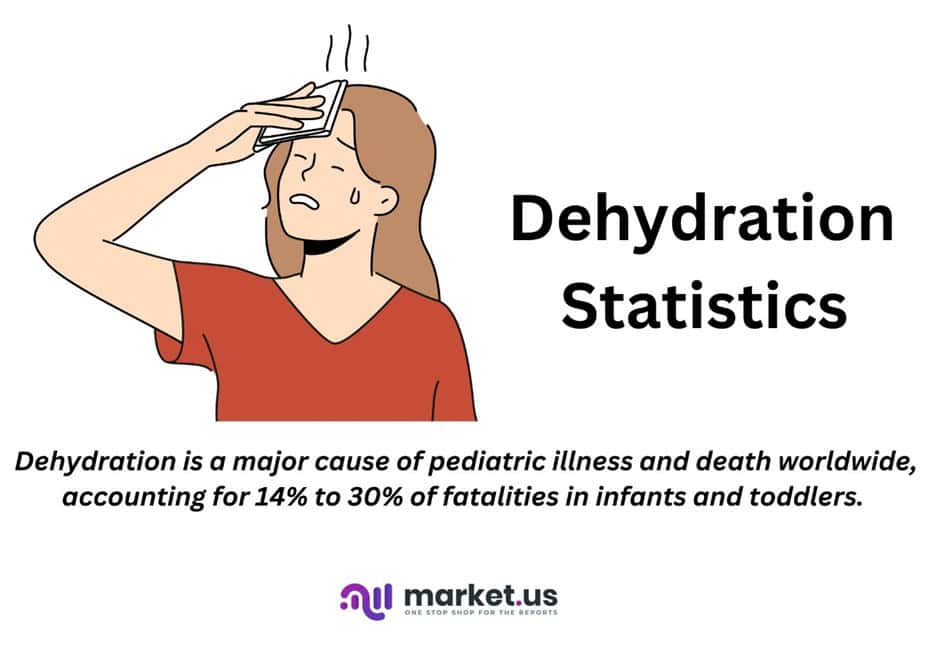
Editor’s Choice
- The Bottled Water Market is anticipated to be USD 551.2 billion by 2033. It is estimated to record a steady CAGR of 5.3% in the Forecast period 2023 to 2033. It is likely to total USD 328.9 billion in 2023.
- Dehydration is commonly caused by various factors. With diarrhea being the leading cause, reported by 73.4% of cases.
- Dehydration is associated with a range of symptoms. With thirst being the most commonly reported, affecting 83.9% of individuals.
- Restoring fluid loss is influenced by several commonly reported factors. Exposure to a hot climate significantly impacts fluid restoration, affecting 59.3% of cases.
- Dehydration is a major cause of pediatric illness and death worldwide. Accounting for 14% to 30% of fatalities in infants and toddlers, mainly due to diarrheal diseases.
- In healthy adults weighing around 70 kg, water constitutes approximately 60% of body weight. With a recommended daily intake of 2.0 to 3.5 liters.
- Dehydration prevalence varies by age, affecting 16-21% of individuals, with symptoms like thirst, dry mouth, decreased urination, and darkened urine indicating its presence. Severe dehydration can lead to rapid weight loss.
- In the United States, the Food and Drug Administration (FDA) sets guidelines under the Food Safety Modernization Act (FSMA). Which mandates preventive controls and hazard analysis for dehydrated foods.
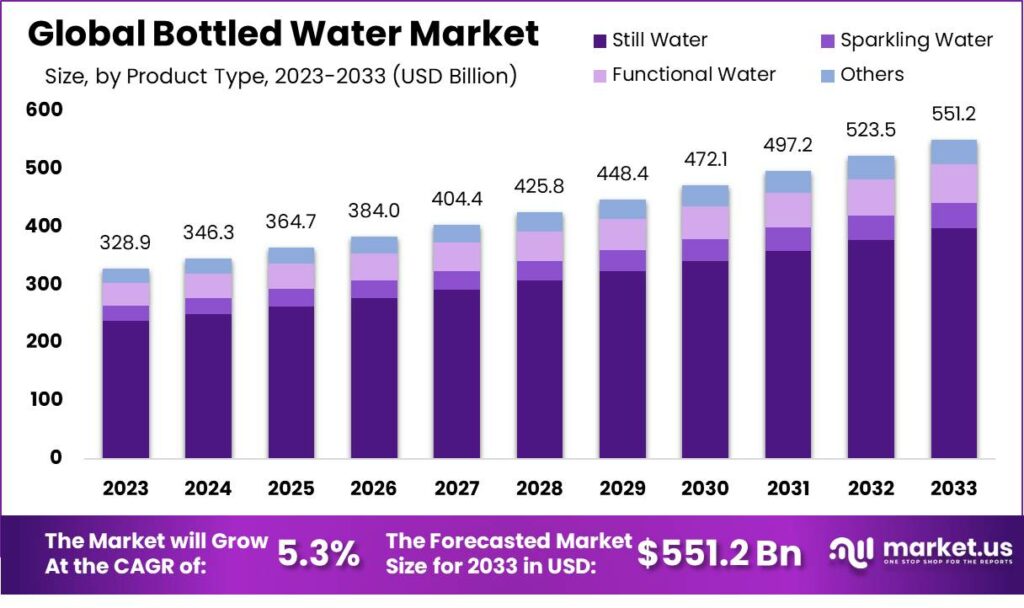
Water Consumption Due to Dehydration Statistics
Global Water Withdrawal and Consumption
- From 2014 to 2040, water withdrawal and consumption are projected to experience a notable increase.
- In 2014, water withdrawal was recorded at 3,980 billion cubic meters, with consumption at 1,405 billion cubic meters.
- By 2025, these figures are expected to rise to 4,180 billion cubic meters for withdrawal and 1,565 billion cubic meters for consumption.
- The upward trend is projected to continue, with water withdrawal anticipated to reach 4,350 billion cubic meters and consumption to increase to 1,720 billion cubic meters by 2040.
- These projections indicate a steady escalation in both water withdrawal and consumption over the specified period.
(Source: Statista)
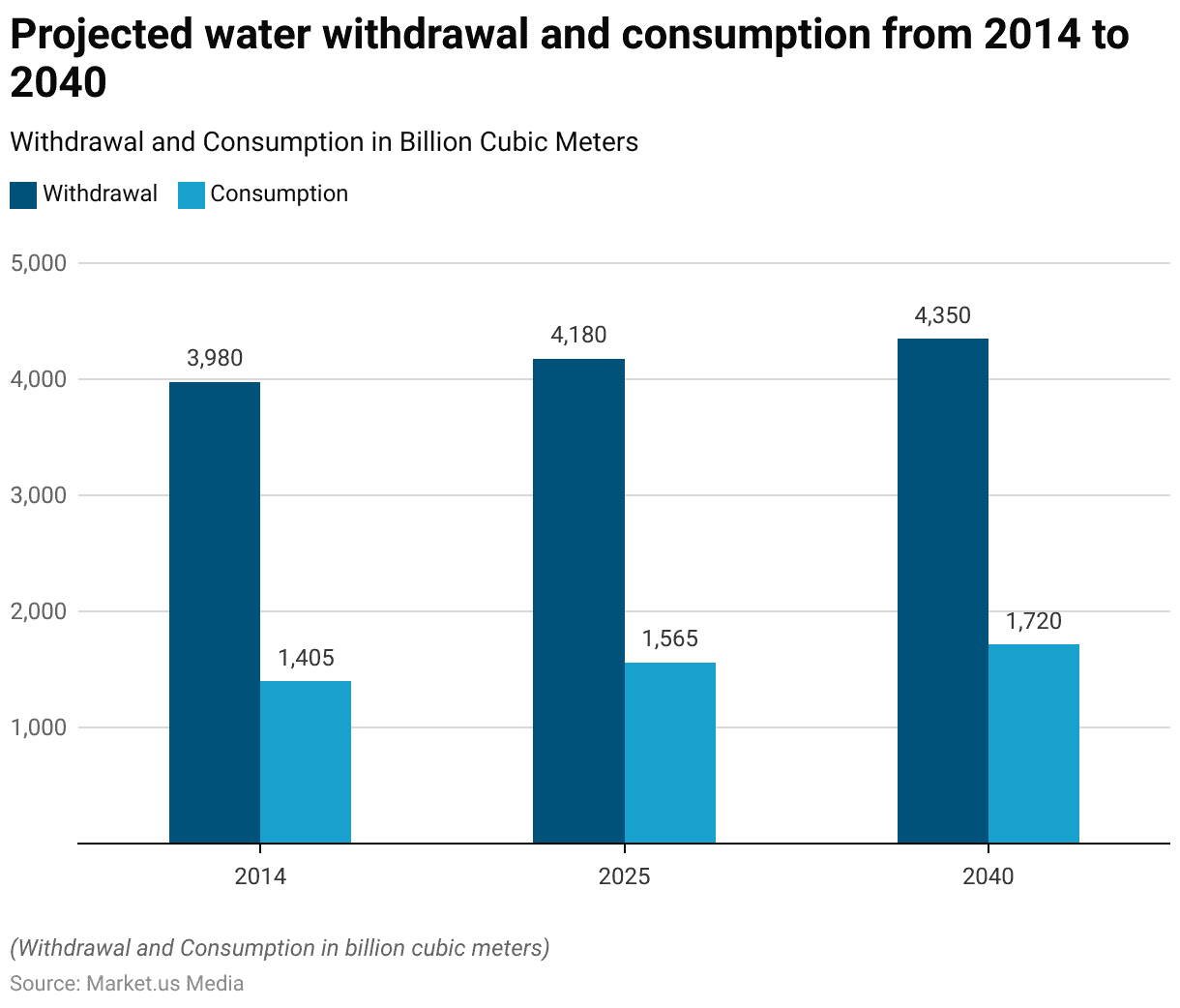
Global Water Withdrawals – Dehydration Statistics By Country
- As of 2022, water withdrawals per capita worldwide exhibited significant variation across select countries.
- Colombia led with per capita withdrawals of 2,008.03 cubic meters. Followed by Peru at 1,682.31 cubic meters and Azerbaijan at 1,257.44 cubic meters.
- The United States also had substantial withdrawals at 1,207.34 cubic meters per inhabitant.
- Other notable figures included Armenia with 1,062.89 cubic meters, Greece with 972.29 cubic meters, and Estonia with 890.6 cubic meters.
- Canada reported 863.01 cubic meters per capita, while Turkey and Bulgaria had 761.92 and 732.17 cubic meters, respectively.
- Mexico and Australia followed with 697.39 and 631.38 cubic meters.
- Costa Rica’s per capita water withdrawals stood at 625.85 cubic meters. Spain at 621.8 cubic meters, and Japan at 619.94 cubic meters.
- Additional countries such as Georgia, Hungary, and the Netherlands reported withdrawals of 583.56, 513.02, and 453.21 cubic meters per inhabitant, respectively.
- Saudi Arabia and Russia had lower figures at 433.28 and 415.44 cubic meters. With Korea, China, and Slovenia at 411.98, 398.95, and 392.18 cubic meters.
- Romania and France concluded the list with per capita withdrawals of 383.46 and 368.97 cubic meters, respectively.
(Source: Statista)
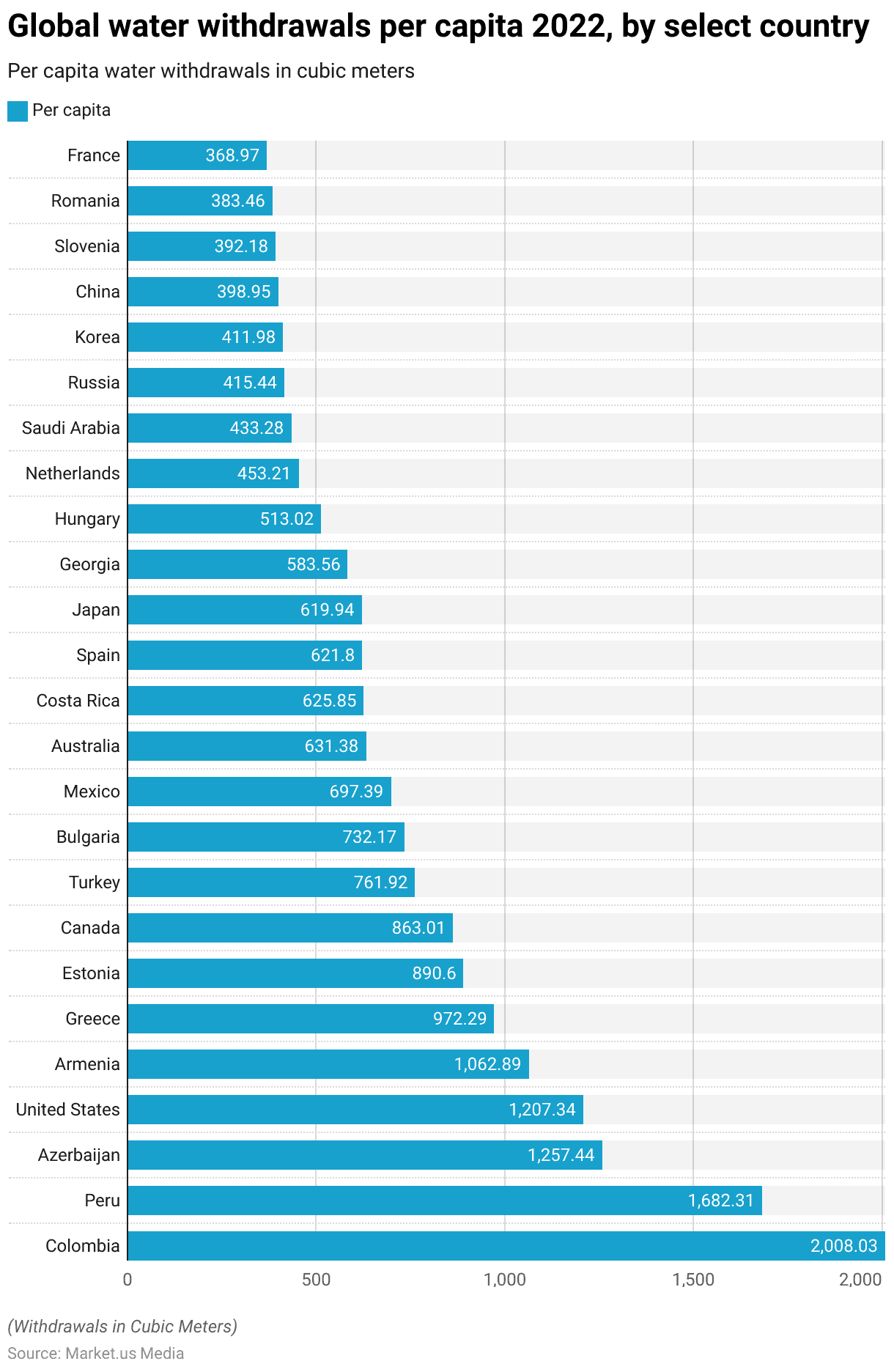
Water Consumption – Dehydration Statistics By Country
- In terms of water usage, the top 10 countries demonstrate significant disparities in their total consumption.
- China leads the list with a staggering 362 trillion gallons of water used annually.
- The United States follows with 216 trillion gallons.
- Brazil ranks third with 95 trillion gallons, while Russia uses 71 trillion gallons.
- Mexico’s water usage stands at 53 trillion gallons, and India utilizes 30 trillion gallons. Both England and France report water usage of 20 trillion gallons each.
- Canada uses 19 trillion gallons, and Australia rounds out the top ten with 12 trillion gallons of water usage annually.
(Source: Water World)
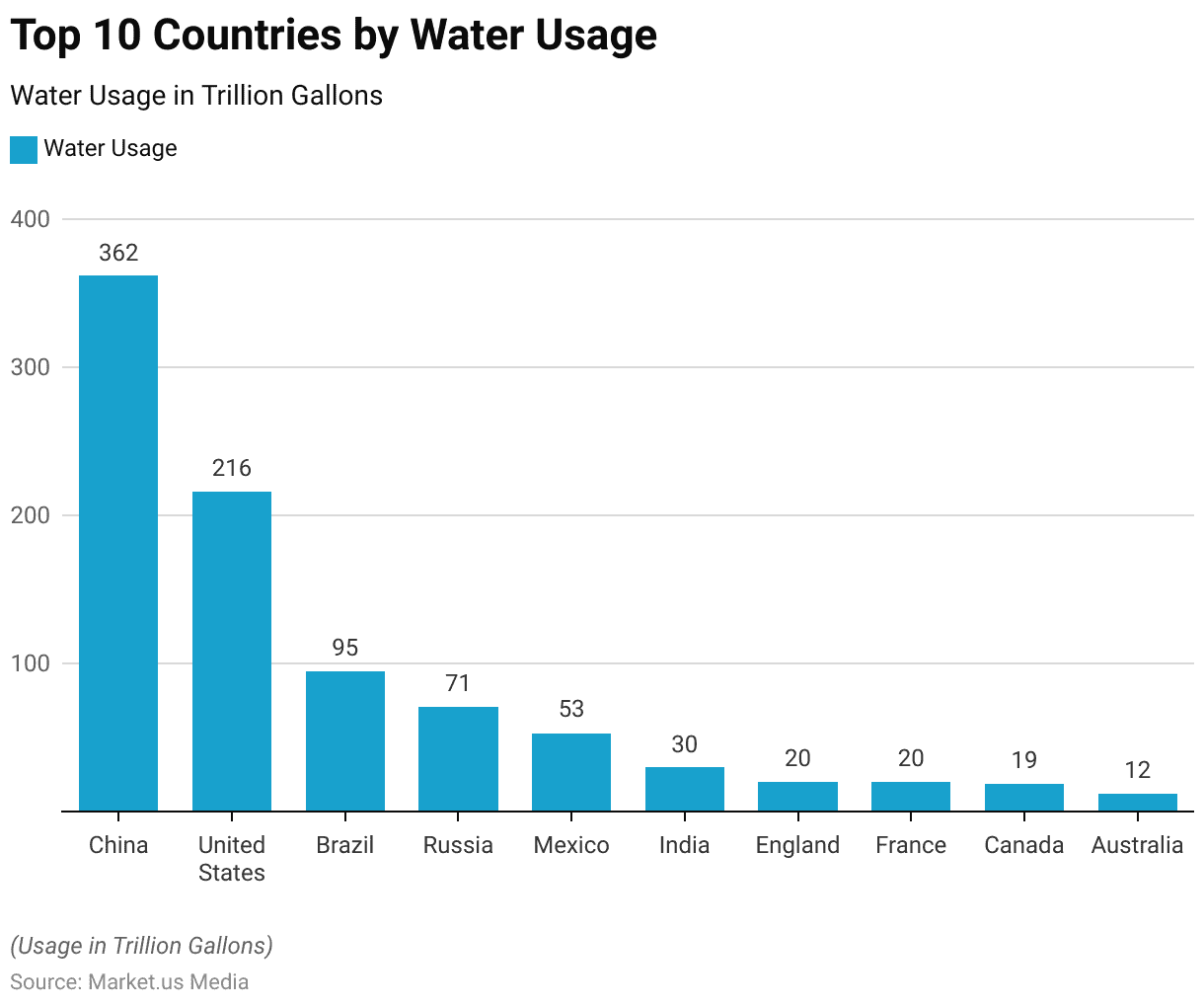
Drinking Water Statistics
Global Urban and Rural Drinking Water Coverage
- In 2022, the global coverage of drinking water for urban and rural populations exhibited marked differences depending on the water source.
- In rural areas, 3% of the population relied on surface water, while this figure was negligible in urban areas.
- Unimproved water sources served 7% of the rural population compared to 1% of the urban population.
- Limited water sources were used by 6% of rural inhabitants and 2% of urban dwellers.
- Basic water services covered 22% of rural residents and 16% of urban residents.
- The majority of the population in both settings had access to safely managed drinking water. With 62% coverage in rural areas and 81% in urban areas.
- These statistics highlight the disparities in water access between urban and rural populations and the varying levels of water source improvement and safety.
(Source: Statista)
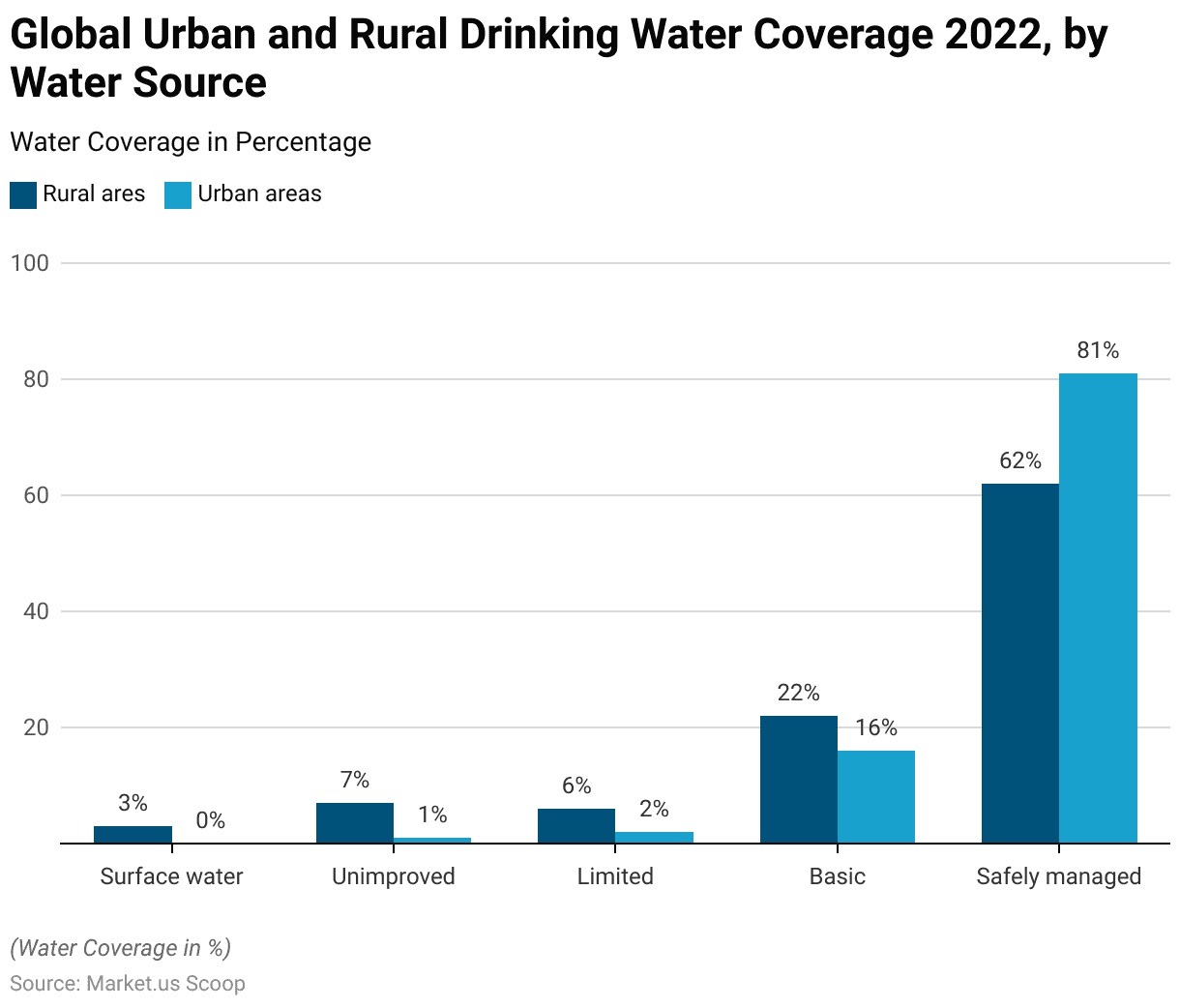
Quality of the World’s Drinking Water Supply
- From 1990 to 2020, the global proportion of the population with access to improved drinking water sources has seen a significant increase. While reliance on unimproved sources has markedly decreased.
- In 1990, 76% of the population had access to improved water sources, with 24% depending on unimproved sources.
- By 1995, the percentage with improved access rose to 79%, reducing those using unimproved sources to 21%.
- The trend continued, with improved access reaching 83% in 2000 and further increasing to 86% by 2005.
- In 2010, 89% of the global population had access to improved water sources. While those using unimproved sources dropped to 11%.
- This positive trend persisted, with 91% of the population accessing improved sources by 2015, maintaining the proportion using unimproved sources at 11%.
- By 2020, a notable 94% of the global population had access to improved drinking water sources, leaving only 7% reliant on unimproved sources.
- This data underscores the substantial progress made over three decades in enhancing global access to safe drinking water.
(Source: Statista)

Fluid Intake Recommendations
- The recommended daily fluid intake varies by age and gender, with specific guidelines to ensure adequate hydration.
- For infants aged 0–6 months, the intake is 0.7 liters, while infants aged 7–12 months should have a total of 0.8 liters, with 0.6 liters coming from fluids.
- Children aged 1–3 years require 1.0 liters or about 4 cups, and those aged 4–8 years need 1.2 liters or about 5 cups.
- Boys aged 9–13 years are advised to consume 1.6 liters or about 6 cups. Increasing to 1.9 liters or about 7–8 cups for boys aged 14–18 years.
- Girls aged 9–13 years should drink 1.4 liters or about 5–6 cups. While those aged 14–18 years need 1.6 liters or about 6 cups.
- For adults, men aged 19 years and older should aim for 2.6 liters or about 10 cups, and women of the same age should consume 2.1 liters or about 8 cups.
- Pregnant girls aged 14–18 years require 1.8 liters or about 7 cups, and pregnant women aged 19 years and older need 2.3 liters or about 9 cups.
- Lactating girls aged 14–18 years should intake 2.3 litres or about 9 cups while lactating women aged 19 years and older are advised to consume 2.6 liters or about 10 cups.
- These guidelines ensure proper hydration for various age groups and physiological conditions.
(Source: Better Health – Victoria State Government)
Causes of Dehydration Statistics
- Dehydration is commonly caused by various factors, with diarrhea being the leading cause, reported by 73.4% of cases.
- Sweating accounts for 52.05% of dehydration incidents, closely followed by vomiting, which is responsible for 51.82%.
- Fever contributes to 39.8% of dehydration cases, while urination is a cause in 35.9%.
- Additionally, travel is reported as a cause of dehydration in 15.9% of cases.
- These statistics highlight the primary contributors to dehydration. Emphasizing the importance of recognizing and managing these factors to maintain proper hydration levels.
(Source: Cambridge University)

Symptoms of Dehydration Statistics
- Dehydration is associated with a range of symptoms, with thirst being the most commonly reported, affecting 83.9% of individuals.
- Dry lips are experienced by 82.5%, while a dry tongue is reported by 68.4%.
- Dry skin affects 55.5% of those dehydrated, and fatigue is a symptom in 45.9% of cases.
- Decreased urination is noted by 42%, and dark-colored urine is observed by 40.9%.
- Lack of focus impacts 38.9% of individuals, and headache is a symptom for 37.5%.
- Dizziness is reported by 33.6%, and light-headedness by 27.5%.
- Muscle weakness is experienced by 27.3%, while rapid breathing and rapid pulse are reported by 25.5% and 23.9%, respectively.
- Less commonly, dehydration can lead to pimples (18.2%) and muscle cramps (17.5%).
- These symptoms underscore the importance of maintaining adequate hydration to prevent the varied and often severe effects of dehydration.
(Source: Cambridge University)
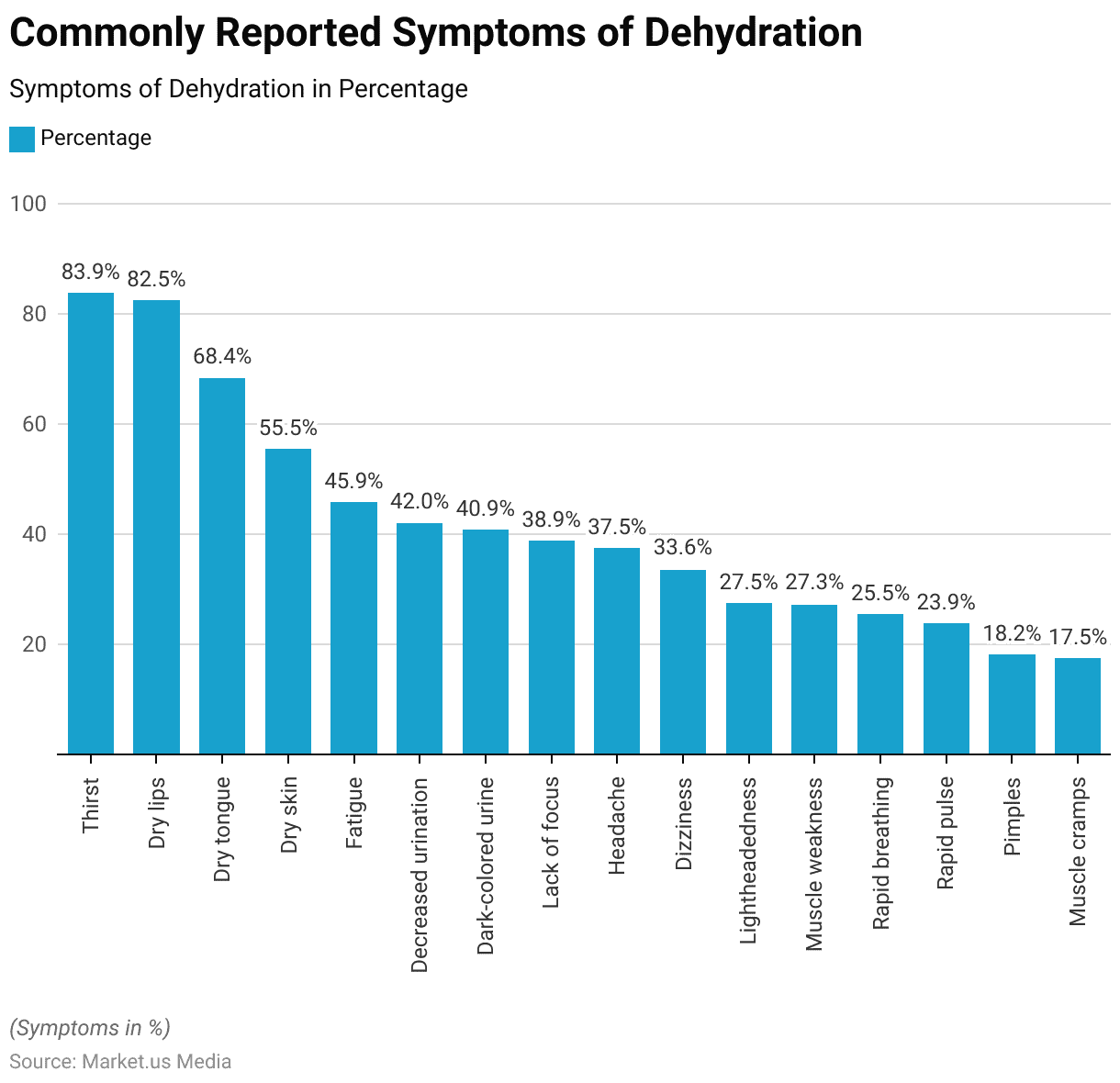
Factors That Affect Restoring Fluid Loss
- Restoring fluid loss is influenced by several commonly reported factors.
- Exposure to a hot climate significantly impacts fluid restoration, affecting 59.3% of cases.
- Diarrhea is another major factor, reported by 44.3% of individuals.
- Exercise contributes to fluid loss in 43.2% of cases. While exposure to a humid climate affects 42% of individuals.
- These factors highlight the importance of considering environmental and physical conditions when addressing fluid restoration needs to maintain proper hydration.
(Source: Cambridge University)
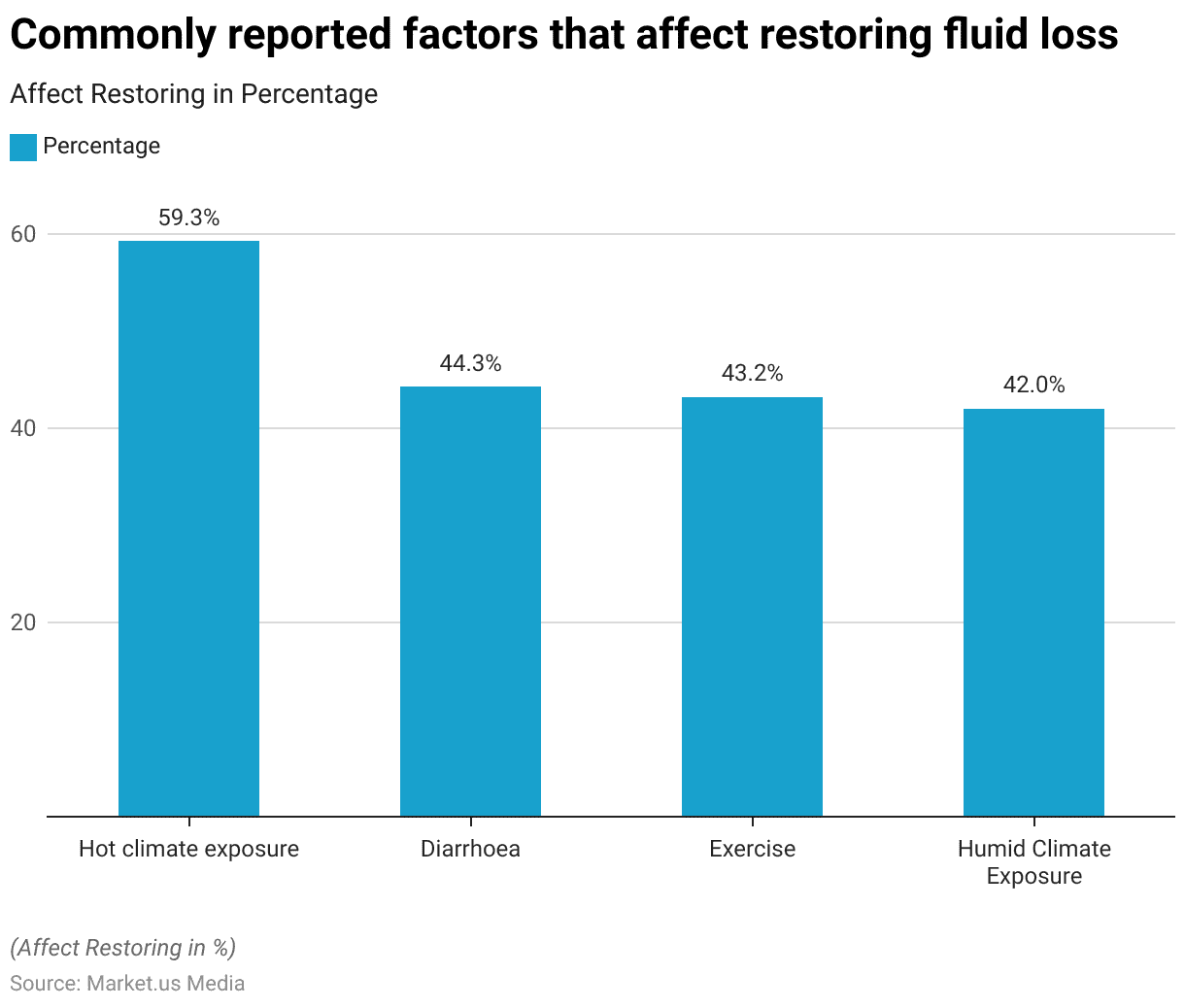
Pediatric Dehydration Statistics
Epidemiology
- Dehydration is a major cause of pediatric illness and death worldwide. Accounting for 14% to 30% of fatalities in infants and toddlers, mainly due to diarrheal diseases.
- Viruses are the primary agents of gastroenteritis globally, with rotavirus being the most common cause. In the United States, however, rotavirus cases have decreased since the 2006 introduction of the oral vaccine, making norovirus and other enteroviruses more common.
- According to the World Health Organization (WHO), dehydration results from excessive body water loss. Infants and children have a higher total body water percentage (65% to 80%) than adults. They are especially susceptible to dehydration because they cannot effectively communicate their thirst or access fluids on their own.
- Diarrhea and dehydration cause significant health issues and approximately 700,000 to 800,000 child deaths annually, accounting for nearly 16% of global child fatalities.
- Most cases occur in South Asia and Sub-Saharan Africa. The WHO’s efforts reduced mortality by 75% from the 1980s to 2008, but progress has stalled. In Ethiopia, poor sanitation and unsafe water contribute to around 10,000 child deaths yearly.
- Pakistan has the highest infant mortality in Asia from diarrheal diseases. With gastroenteritis and dehydration causing about 60% of child deaths.
- In the U.S., these conditions lead to over 200,000 hospitalizations annually but are not a major cause of death. Regions with high breastfeeding rates, safe water, proper sanitation, and rotavirus vaccines see fewer cases of severe pediatric diarrhea and dehydration.
Etiology, Pathophysiology, and Physiology
- Acute infectious gastroenteritis is the leading cause of dehydration, with viral infections such as rotavirus, norovirus, and enteroviruses responsible for 75% to 90% of global cases.
- Bacterial pathogens account for less than 20%, though in resource-limited countries, this can exceed 25% in children with gastroenteritis.
- In children under 2, rotavirus is the most common cause. Still, since the introduction of the rotavirus vaccine in 2006, hospitalizations for dehydration have declined, while norovirus and other enteric viruses have become more prevalent.
- Dehydration reduces total body water (TBW), affecting both intracellular and extracellular fluids. TBW comprises 70% to 80% of an infant’s body weight, 65% in children, and 45% to 60% in adults. Extracellular water is divided into interstitial space (75%) and plasma (25%).
- Dehydration severity is categorized as mild (3% to 5%), moderate (6% to 10%), or severe (over 10%), with signs and symptoms varying accordingly. Infants, having higher TBW percentages, lose more body weight compared to older children at the same dehydration level.
(Source: National Library of Medicine)
Adult Dehydration Statistics
Epidemiology and Etiology
- In healthy adults weighing around 70 kg, water constitutes approximately 60% of body weight, with a recommended daily intake of 2.0 to 3.5 liters. Water intake comes from three main sources: drinking fluids, water-rich foods, and metabolic processes (endogenous water).
- Even a 3% loss in body weight from water depletion can indicate dehydration, which is linked to cognitive impairments like poor memory and attention.
- Dehydration results from an imbalance between water intake and loss, particularly problematic for older adults, increasing the risk of conditions such as constipation, dental issues, urinary tract infections, and kidney stones.
- Dehydration prevalence varies by age, affecting 16-21% of individuals, with symptoms like thirst, dry mouth, decreased urination, and darkened urine indicating its presence. Severe dehydration can lead to rapid weight loss.
- Global surveys highlight inadequate awareness of hydration needs. Studies in China and Australia found significant gaps in understanding minimum daily water requirements and frequent reliance on thirst as a signal to drink water.
- Older adults face a higher risk of dehydration, up to 20-30% more than younger adults, due to factors including reduced mobility, impaired thirst sensation, diabetes, renal disease, and susceptibility to falls.
(Sources: National Library of Medicine, Cambridge University)
Dried and Dehydrated Products Statistics
Dried Fruit Production Worldwide
- In the 2022/2023 period, the worldwide production of dried fruits varied significantly by type, with dried grapes leading the category at 1,306,700 thousand metric tons.
- Table dates followed closely with a production volume of 1,157,000 thousand metric tons.
- Dried cranberries were produced in smaller quantities, amounting to 194,836 thousand metric tons.
- Prunes also had a notable production volume of 171,660 thousand metric tons, while dried apricots reached 165,810 thousand metric tons.
- Dried figs had the lowest production among the listed types, totaling 134,000 thousand metric tons.
- These figures highlight the dominance of dried grapes and table dates in global dried fruit production.
(Source: Statista)
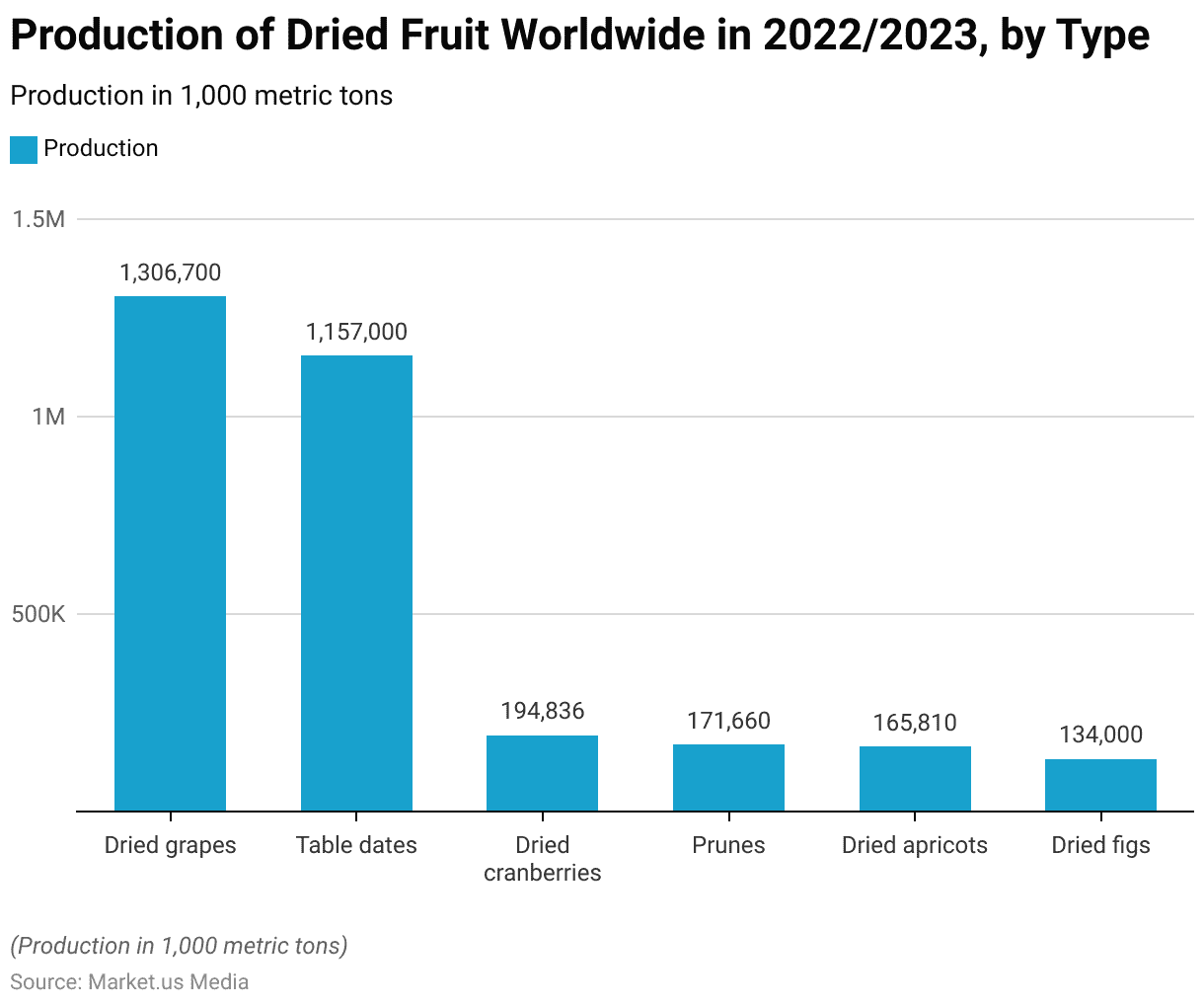
Shipment Value of Dried and Dehydrated Fruits and Vegetables
- The value of product shipments of dried and dehydrated fruits and vegetables in the United States has shown notable fluctuations and growth from 2002 to 2016.
- In 2002, the shipment value was $2.5 billion, increasing to $2.8 billion in 2003.
- The value then decreased to $2.3 billion in 2004 but rose again to $2.4 billion in 2005 and remained stable in 2006.
- In 2007, the value climbed to $3 billion and maintained this level through 2008.
- A slight decline occurred in 2009, with shipments valued at $2.8 billion, but by 2010, the value had returned to $3 billion.
- The upward trend continued, reaching $3.3 billion in 2011 and $3.8 billion in both 2012 and 2013.
- The shipment value peaked at $4 billion in 2014, followed by further growth to $4.3 billion in 2015.
- In 2016, the value slightly decreased to $4.2 billion.
- This period highlights a general upward trend in the value of shipments, reflecting increasing demand and market growth for dried and dehydrated fruits and vegetables in the United States.
(Source: Statista)

Per Capita Consumption of Dried Fruits
- The per capita consumption of dried fruit in the United States from the 2000/01 to 2022/23 period has experienced various fluctuations.
- In the 2000/01 period, consumption was at 2.46 pounds per capita, slightly decreasing to 2.43 pounds in 2001/02. The following year saw an increase to 2.59 pounds in 2002/03.
- However, consumption dropped to 2.32 pounds in 2003/04 and remained relatively stable, with minor variations, over the next several years. For instance, it was 2.34 pounds in both 2004/05 and 2006/07, while dipping slightly to 2.29 pounds in 2005/06 and 2.25 pounds in 2007/08.
- A gradual decline continued, reaching 2.14 pounds in 2009/10. After that, a slight upward trend was observed, with consumption rising to 2.26 pounds in 2010/11 and 2.31 pounds in 2011/12.
- The 2013/14 period saw consumption at 2.44 pounds, followed by fluctuations between 2.27 and 2.42 pounds through 2015/16. The period from 2016/17 to 2018/19 witnessed another decline, bottoming out at 2.04 pounds.
- A modest recovery followed, with consumption rising to 2.3 pounds in 2019/20 before experiencing minor declines in the subsequent years, ending at 2.22 pounds per capita in 2022/23.
- These trends reflect changing consumer preferences and market dynamics over the 22 years.
(Source: Statista)
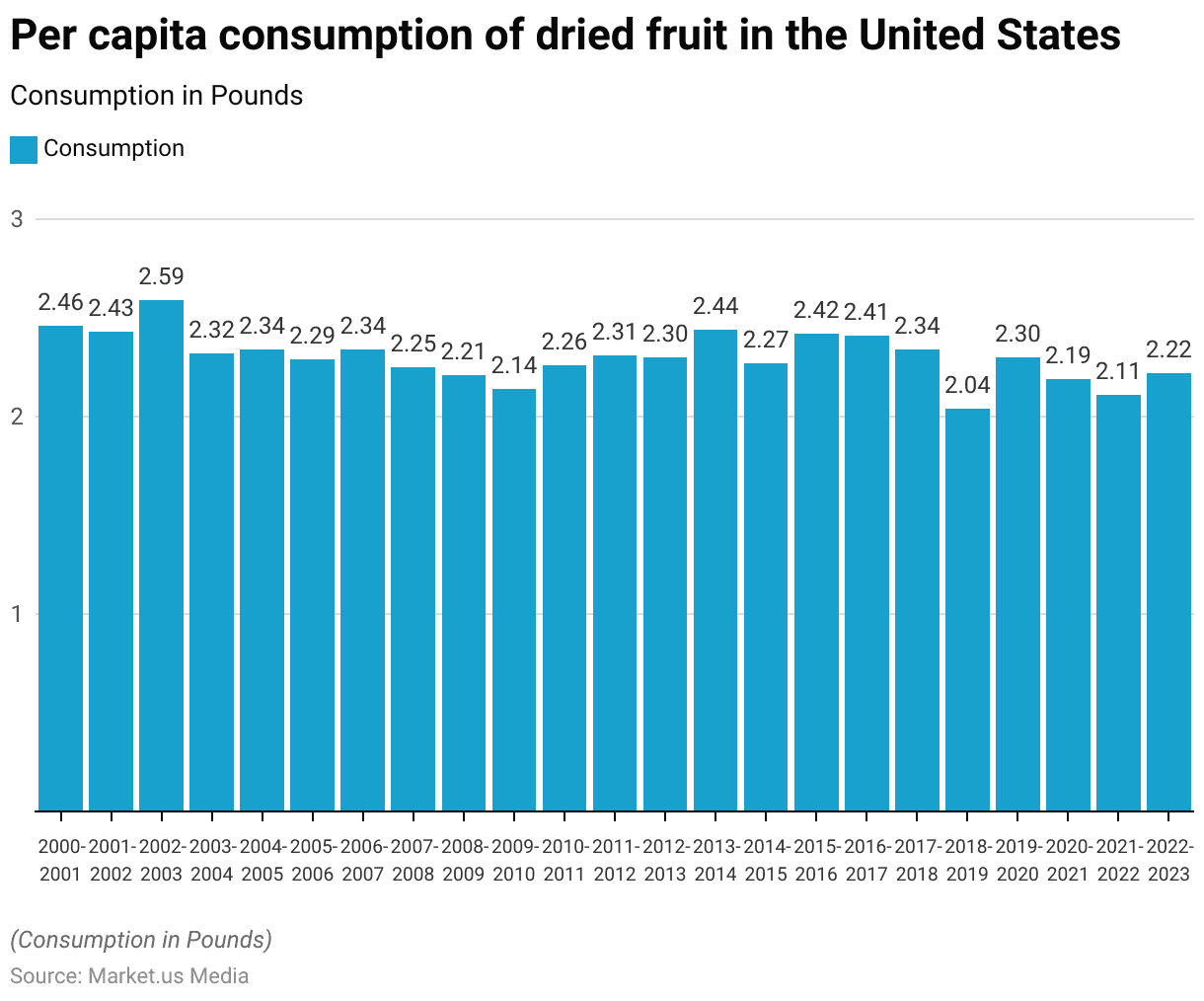
Dehydration Treatment Solutions Statistics
Oral Rehydration Solutions and Commonly Used Beverages
Major Dehydration Treatment Beverages Statistics
- A comparison of the composition of oral rehydration solutions and commonly used beverages reveals significant differences in their carbohydrate, sodium, potassium, base, and osmolarity content.
- Pedialyte contains 25 g/L of dextrose, 45 mEq/L of sodium, 20 mEq/L of potassium, and 30 mEq/L of base and has an osmolarity of 250 mOsm/kg.
- Enfalyte, with corn syrup as its carbohydrate source, provides 30 g/L of carbohydrates, 50 mEq/L of sodium, 25 mEq/L of potassium, 30 mEq/L of base, and an osmolarity of 200 mOsm/kg.
- CeraLyte, made from rice, offers 40 g/L of carbohydrates, 70 mEq/L of sodium, 20 mEq/L of potassium, ten mEq/L of base, and an osmolarity of 235 mOsm/kg.
- The WHO 2002 solution contains 13.5 g/L of carbohydrates, 75 mEq/L of sodium, 20 mEq/L of potassium, and 30 mEq/L of base and has an osmolarity of 245 mOsm/kg.
Other Overcoming Dehydration Beverages Statistics
- In contrast, common beverages like Gatorade have 45 g/L of carbohydrates, 20 mEq/L of sodium, 3 mEq/L of potassium, 3 mEq/L of base, and an osmolarity ranging from 280 to 360 mOsm/kg.
- POWERADE contains 58 g/L of carbohydrates, 10 mEq/L of sodium, 3 mEq/L of potassium, 1 mEq/L of base, and has an osmolarity of 403 mOsm/kg.
- Apple juice has a high carbohydrate content of 100–150 g/L, three mEq/L of sodium, 20 mEq/L of potassium, no base, and an osmolarity of 700 mOsm/kg. Tea, containing no carbohydrates, sodium, potassium, or base, has a very low osmolarity of 5 mOsm/kg.
- Ginger ale has 90 g/L of carbohydrates, 3.5 mEq/L of sodium, 0.1 mEq/L of potassium, 3.6 mEq/L of base, and an osmolarity of 565 mOsm/kg.
- Cola, similar to apple juice, contains 100–150 g/L of carbohydrates, two mEq/L of sodium, 0.1 mEq/L of potassium, 13 mEq/L of base, and has an osmolarity of 550 mOsm/kg.
- Chicken broth is notably high in sodium at 250 mEq/L, with no carbohydrates or base, five mEq/L of potassium, and an osmolarity of 450 mOsm/kg.
(Source: Brook Medicine)
Guidelines for Administration of Dehydration Treatment Solutions
Administration of Oral Dehydration Solutions Guidelines and Statistics
- The guidelines for administering oral solutions to replace fluid deficit over four hours differ based on the severity of dehydration.
- For mild dehydration, which is characterized by a fluid loss of 3%–5% of body weight, the total volume of oral solution to be administered over four hours varies by weight. For a body weight of 5 kg, the total volume required is 150–250 mL, administered in 5 mL increments every 5–8 minutes.
- For 10 kg, 300–500 mL is needed, with 6–10 mL administered every 5 minutes. At 15 kg, 450–750 mL should be given in 10–15 mL increments every 5 minutes. For 20 kg, 600–1,000 mL is required, with 12–20 mL administered every 5 minutes.
- For 25 kg, 750–1,250 mL should be given in 15–25 mL increments every 5 minutes. At 30 kg, 900–1,500 mL is needed, with 18–30 mL administered every 5 minutes.
- For a body weight of 40 kg, the total volume required is 1,200–2,000 mL, administered in 25–40 mL increments every 5 minutes.
(Source: Brook Medicine)
Moderate Dehydration Guidelines and Statistics
- For moderate dehydration, characterized by a fluid loss of 6%–9% of body weight, the volumes increase.
- For a body weight of 5 kg, 300–450 mL is needed, with 6–9 mL administered every 5 minutes. For 10 kg, 600–900 mL is required in 12–18 mL increments every 5 minutes. At 15 kg, 900–1,350 mL should be given, with 18–28 mL administered every 5 minutes.
- For 20 kg, 1,200–1,800 mL is needed, with 25–37 mL administered every 5 minutes. For 25 kg, 1,500–2,250 mL is required, with 30–45 mL administered every 5 minutes.
- At 30 kg, 1,800–2,700 mL should be given in 37–55 mL increments every 5 minutes. For a body weight of 40 kg, 2,400–3,600 mL is needed, administered in 50–75 mL increments every 5 minutes.
- These guidelines ensure appropriate fluid replacement tailored to body weight and dehydration severity, facilitating effective rehydration within a critical time frame.
(Source: Brook Medicine)
Initiatives and Programs to Combat Dehydration Statistics
- To combat dehydration, various initiatives and programs have been implemented by both government and private organizations.
- The Biden-Harris Administration launched the ALL INside initiative, aimed at reducing unsheltered homelessness, which includes providing essential resources such as clean drinking water to vulnerable populations.
- The U.S. Interagency Council on Homelessness collaborates with state and local governments to enhance access to hydration and other critical services for the homeless.
- Private organizations, such as Blanchet House, focus on local efforts to combat dehydration among the homeless by organizing water donation drives, advocating for hydration stations, and distributing bottled water directly to those in need.
- Additionally, GiveWell supports water chlorination programs, which ensure safe drinking water in developing regions, thereby reducing dehydration caused by unsafe water consumption.
- These combined efforts from both public and private sectors emphasize the importance of accessibility to clean water and hydration education to prevent dehydration and its associated health risks.
(Source: The White House, Blanchet House, GiveWell)
Regulations for Dehydration Products Statistics
- The regulations for dehydration products vary significantly across different countries, aiming to ensure food safety and consumer protection.
- In the United States, the Food and Drug Administration (FDA) sets guidelines under the Food Safety Modernization Act (FSMA), which mandates preventive controls and hazard analysis for dehydrated foods.
- The European Union follows the European Food Safety Authority (EFSA) regulations, which include strict hygiene standards and labeling requirements.
- In Japan, the Ministry of Health, Labour, and Welfare (MHLW) oversees food safety, emphasizing proper processing and storage practices.
- China‘s regulations, managed by the National Health Commission (NHC), focus on food additives and contaminants. At the same time, India‘s Food Safety and Standards Authority (FSSAI) mandates compliance with its Food Safety and Standards (Food Products Standards and Food Additives) Regulations.
- These regulations collectively ensure that dehydrated food products are safe for consumption, maintain quality, and provide accurate information to consumers.
(Source: World Health Organization (WHO), World Population Review)
Recent Developments
Acquisitions and Mergers:
- Nestlé acquires Nuun: In mid-2023, Nestlé acquired Nuun, a company specializing in hydration products, for $50 million. This acquisition aims to expand Nestlé’s portfolio in the sports nutrition and hydration market by integrating Nuun’s electrolyte tablets and hydration solutions.
- Unilever acquires Liquid I.V.: Unilever completed its acquisition of Liquid I.V., a hydration-focused wellness brand, for $600 million in late 2023. This merger is expected to enhance Unilever’s health and wellness offerings, particularly in the rapidly growing hydration segment.
New Product Launches:
- Gatorade’s Smart Hydration System: In early 2024, Gatorade introduced its Smart Hydration System, featuring a smart bottle and sweat patch that work together to track hydration levels and provide personalized recommendations for optimal hydration.
- Hydrant’s Immunity Line: Hydrant launched a new line of hydration products in mid-2023, designed to support immune health. These products combine electrolytes with vitamins and minerals to enhance both hydration and immune function.
Technological Advancements:
- Advanced Hydration Monitoring: Advances in wearable technology are enabling more accurate monitoring of hydration levels through devices that track sweat rate, electrolyte loss, and fluid intake, providing real-time data to help maintain optimal hydration.
- Enhanced Oral Rehydration Solutions: New formulations of oral rehydration solutions are being developed to improve absorption rates and effectiveness, combining traditional electrolytes with amino acids and other bioactive compounds.
Market Dynamics:
- Growth in Hydration Market: The global hydration products market is projected to grow at a CAGR of 8.2% from 2023 to 2028, driven by increasing awareness of the importance of hydration, the rise of sports and fitness activities, and the demand for convenient hydration solutions.
- Rising Demand for Functional Beverages: There is a growing demand for functional beverages that offer additional health benefits beyond hydration, such as energy boosts, immune support, and enhanced recovery, contributing to market expansion.
Regulatory and Strategic Developments:
- EU Health Claims Regulation Compliance: Companies producing hydration products are ensuring compliance with the EU’s Health Claims Regulation, providing clear and scientifically backed claims about the benefits of their products to gain consumer trust.
- US FDA Guidelines for Hydration Products: In early 2024, the US FDA issued updated guidelines for hydration products, emphasizing the need for accurate labeling, safety standards, and evidence-based claims to protect consumers.
Research and Development:
- Personalized Hydration Solutions: R&D efforts are focusing on developing personalized hydration solutions that cater to individual needs based on factors such as age, activity level, and health conditions, providing tailored hydration strategies.
- Sustainable Packaging Innovations: Researchers are exploring sustainable packaging options for hydration products, such as biodegradable and recyclable materials, to reduce environmental impact and appeal to eco-conscious consumers.
Conclusion
Dehydration Statistics – Dehydration occurs when the body loses more fluids than it consumes, leading to an imbalance that can disrupt normal bodily functions.
Recognizing and preventing dehydration is crucial for maintaining overall health, as it can affect anyone but poses higher risks for infants, young children, the elderly, and those with chronic illnesses.
Symptoms of dehydration range from mild—such as thirst and dry mouth—to severe, including confusion and rapid heartbeat, which may require medical intervention.
Prevention strategies include drinking adequate fluids, consuming water-rich foods, and using oral rehydration solutions during illness or intense physical activity.
Awareness and timely management are essential, particularly in vulnerable populations and extreme conditions.
By understanding the signs and addressing the causes, dehydration can be effectively managed, ensuring better health and well-being.
FAQs
Dehydration occurs when your body loses more fluids than it takes in. Leading to a deficiency of water and other essential fluids needed for normal body functions. This can result from excessive sweating, vomiting, diarrhea, or inadequate fluid intake.
Common symptoms include thirst, dry mouth, dry skin, fatigue, dizziness, decreased urine output, dark-colored urine, and headache. Severe dehydration can cause confusion, rapid heartbeat, sunken eyes, and low blood pressure.
Prevent dehydration by drinking plenty of fluids, especially water, throughout the day. Increase fluid intake during hot weather, exercise, or illness. Eating water-rich foods like fruits and vegetables can also help maintain hydration.
Infants, young children, the elderly, and individuals with chronic illnesses are at higher risk of dehydration. Athletes, outdoor workers, and those living in hot climates are also more susceptible.
Mild dehydration can often be treated by drinking water or oral rehydration solutions (ORS) that contain electrolytes. Severe dehydration may require intravenous fluids and medical attention to restore proper hydration levels.
Discuss your needs with our analyst
Please share your requirements with more details so our analyst can check if they can solve your problem(s)



